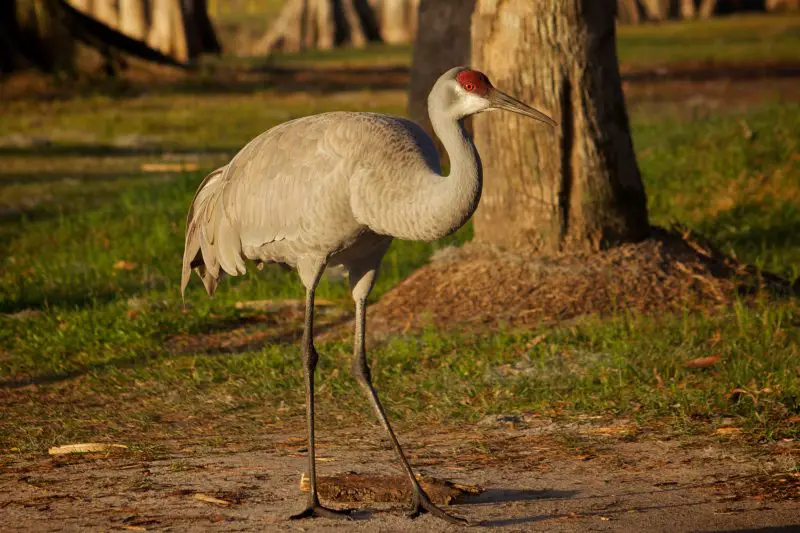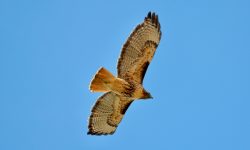With their tall, elegant stature and haunting bugle calls that echo across wetlands, Sandhill Cranes (Grus canadensis) are among the most captivating birds in North America. Towering over marsh grasses and gliding across the sky with their outstretched wings, they seem to belong to an older world—one that predates human memory. These ancient birds, whose lineage reaches back millions of years, continue to inspire birdwatchers, biologists, and nature lovers with their powerful presence and intimate family lives. From their mesmerizing courtship dances to their epic migrations, the Sandhill Crane embodies the rhythms and resilience of the wild.

Understanding the Sandhill Crane
Tall as a child and robed in soft gray feathers that shimmer in the sun, the Sandhill Crane cuts a striking figure across the wetlands. With scarlet crowns blazing above sharp amber eyes and necks that sway like reeds in the wind, these birds embody a wild, ancient elegance. Adults can stand over four feet tall, and when they unfurl their wings—stretching more than seven feet from tip to tip—they become airborne silhouettes gliding silently across open skies.
But it’s not just their appearance that commands attention. Their voices—deep, echoing bugle calls—can pierce the morning mist and travel for miles, rolling like thunder over meadows and marshes. These calls are more than just sound; they are conversations between mates, warnings to strangers, and declarations of belonging that help cranes stay connected in vast, open landscapes.
Sandhill Cranes don’t just seem prehistoric—they are. Fossils show that their kind has walked this Earth for over 2.5 million years, nearly unchanged. In an ever-changing world, they are living relics of deep time, messengers from a wilder past that still whispers through the reeds.
Behavior: Dances, Diet, and Family Bonds
The Ritual of Dance
In the world of birds, few spectacles rival the dance of the Sandhill Crane. As dawn spills gold across the marshes, these towering birds begin a performance as timeless as the land beneath their feet. Mated pairs face each other, bow deeply, and leap into the air in unison—wings wide, feet trailing mist. They circle, toss grass into the wind, and let out piercing calls that echo like instruments in a symphony of courtship.
This elegant ballet is not a one-time affair. Mated pairs renew their bond through dance every year, turning the marsh into a stage where love is reaffirmed through movement and rhythm. And it’s not just for breeding—young cranes and non-mated adults often dance too, suggesting something more: perhaps joy, social expression, or the simple exhilaration of life on open wings.
Feeding Across the Seasons
The Sandhill Crane’s table is as diverse as the landscapes it travels. These omnivorous birds dine with both precision and patience. In muddy wetlands, they probe the earth for snails, worms, and insects, their sharp bills moving like delicate tools. In drier prairies and farmlands, they switch menus—feasting on grains, seeds, and tubers with equal enthusiasm.
This seasonal versatility is a key to their success. Whether walking through flooded fields or dry stubble after the harvest, cranes adapt with quiet intelligence. You’ll often see them moving slowly in small family groups, murmuring softly to one another as they forage—a soundtrack of quiet companionship beneath the vast sky.
Social Lives and Migrations
Though they cherish solitude during breeding, Sandhill Cranes are deeply social birds. Once nesting season ends, they join together in immense, moving congregations—living rivers of gray feathers flowing across the sky. Some flocks number in the tens of thousands, particularly in famous staging grounds like Nebraska’s Platte River, where wetlands become alive with dance, song, and flight.
These cranes are creatures of tradition. Their migratory routes span thousands of miles and have been passed down through generations. Juveniles do not learn to fly south from instinct—they learn by flying beside their parents, wingbeat by wingbeat, mile after mile. Migration is not just a journey of distance, but of memory and legacy, connecting young cranes to ancestral skies and ancient landscapes.
Range and Habitats
Geographic Distribution
From the frozen tundras of Alaska to the sun-drenched wetlands of Florida, Sandhill Cranes trace a vast and ancient path across North America. Their range spans an astonishing sweep of habitats and latitudes, a testament to both their adaptability and their enduring connection to the land. Migratory populations journey thousands of miles each year, nesting in the wild north—Canada, Alaska, and the northern U.S.—before heading south to overwinter in warmer regions.
Yet not all cranes take flight when the seasons shift. Some remain year-round in pockets of the continent, including Florida, Mississippi, and even Cuba, forming resident populations that have adapted to the rhythm of a single place. Scientists recognize six distinct subspecies: three migratory and three non-migratory, each fine-tuned to its home. From icebound meadows to tropical marshes, Sandhill Cranes have learned how to survive—and thrive—in wildly different worlds.
Preferred Ecosystems
Where water meets open sky, Sandhill Cranes find their sanctuary. They favor broad, shallow wetlands—marshes, bogs, floodplains—where grasses sway, and cattails rustle in the wind. These watery realms provide not only food but safety, offering nesting spots hidden from predators and access to the amphibians, tubers, and insects they rely on.
Yet cranes are also masters of adaptation. When migration pulls them across farmlands and prairie, they don’t hesitate to forage in corn stubble or glean grain from rice paddies. These modern landscapes, though shaped by human hands, have become part of the crane’s seasonal rhythm. Still, their needs are specific: open space to spot danger, shallow water to rear young, and quiet places to dance, rest, and remember.
As wild wetlands disappear, the places where cranes can live freely grow fewer. But wherever water shimmers under open sky and wind whispers through grass, the Sandhill Crane may still glide down—legs extended, wings wide—and reclaim its ancestral ground.
Nesting Habits and Reproductive Life
Building a Safe Nest
When spring softens the wetlands and the wind carries the scent of new growth, Sandhill Cranes begin the most tender chapter of their yearly journey: building a home. In shallow marshes or on tiny islands hidden among reeds, a mated pair works side by side, piling cattails, sedges, and grasses into a raised mound. This humble nest, anchored in water and woven by instinct, must protect what matters most.
The female typically lays one or two pale, speckled eggs. From that moment, both parents become sentinels of life, taking turns warming the clutch with their bodies, their long necks coiled in patient vigilance. The location is no accident—surrounded by water, cloaked in vegetation, and close to feeding grounds, it’s a careful compromise between visibility and shelter. Any mistake could mean disaster in a world of hungry predators and rising floodwaters.
Life After Hatching
Then, on a quiet morning, a crack. A golden-brown head pokes through the shell, and a colt—wide-eyed and alert—enters the world. Within hours, it stands on stilt-like legs and wobbles after its parents, ready to walk, learn, and survive. If two chicks hatch, one often edges ahead in strength. In many cases, only one fledges, as competition and risk reduce the odds for the smaller sibling.
But for the one that thrives, the following weeks are filled with discovery. Guided by ever-watchful parents, the colt explores the wetland, learns to forage, and listens to the sky. Danger lurks in every shadow—hawks overhead, coyotes in the grass—but the adults remain fiercely protective, using distraction displays or sharp bills to defend their young.
By late summer, the colt has grown tall and strong, its gray feathers beginning to match its parents. When the winds shift and the days grow shorter, it will take to the air beside them—crossing hundreds of miles of sky—not just as a passenger, but as a new bearer of ancient instincts.
Conservation Status and Ongoing Challenges
A Recovery Success
Not so long ago, the skies were nearly silent where Sandhill Cranes once called. In the 19th and early 20th centuries, as wetlands vanished under the plow and hunters silenced their songs, these majestic birds slipped dangerously close to the edge. But thanks to decades of conservation efforts, the story of the Sandhill Crane has become one of North America’s great comebacks.
Wetland protection, migratory bird treaties, and public awareness campaigns helped reverse their decline. Today, the Greater Sandhill Crane once again dances across the Great Lakes region and western U.S., raising young in marshes that had long stood empty. Their return is not just a triumph for cranes—it’s a sign that ecosystems can heal when given a chance.
Remaining at Risk
Yet the celebration is far from complete. Not all Sandhill Cranes have been so fortunate. The Mississippi Sandhill Crane, a non-migratory subspecies, remains perilously close to extinction. Fewer than a few hundred individuals survive, confined to fragmented habitats along the Gulf Coast, where development creeps ever closer and fire suppression disrupts the pine savannas they need to nest.
Even for stronger populations, the future is uncertain. Wetlands continue to disappear—drained for farms, paved for cities, altered by droughts and floods that arrive out of season. Human disturbance, especially during the fragile nesting period, can drive birds to abandon their young. Climate change adds a deeper, shifting threat, unraveling the delicate timing of food, water, and migration that these birds have followed for millennia.
To protect the Sandhill Crane is to protect more than a species. It is to defend wildness itself: the open marshes, the quiet floodplains, the sky-paths passed down across time. Their bugling calls remind us that what is ancient can endure—if we choose to act in time.
Conclusion
The Sandhill Crane is more than a majestic bird—it is a symbol of the wild’s enduring spirit and a reminder of the deep connections between land, water, and life. From its ancient ancestry to its breathtaking migrations and family-centered nesting habits, every aspect of its life tells a story of resilience, grace, and adaptation. As we continue to alter landscapes and face ecological challenges, the presence of Sandhill Cranes in our skies and wetlands reminds us of the importance of conservation and coexistence. Protecting these birds means safeguarding the intricate ecosystems they depend on, ensuring that future generations will also be able to hear their echoing calls and witness their timeless dances across the changing seasons.






